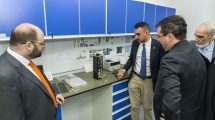
Can you elaborate on how specific AI technologies will be incorporated into SPACE42’s satellite systems and how it positions you compared to your industry peers?
Like other technology sectors, the space sector is evolving fast. The creation of SPACE42 is a strategic step to meet the sector’s demands. As such, we look at everything from developing innovative solutions to transforming business models across various industry sectors and leveraging advanced technological capabilities to seize emerging opportunities and overcome business challenges.
Through our strategic application of AI, we will be able to become more efficient, reach further in space, and deliver services more rapidly. This will be transformative and positively impact the sectors and communities we serve. What’s more, we firmly believe that AI will be essential to democratising space applications. Space exploration is extremely costly, and SPACE42 will help make its applications accessible to more people worldwide.
How do you aim to achieve this?
By introducing a new industry standard and establishing a platform for transformative AI technologies that enable our shared geospatial intelligence and satellite communications services. With AI already powering our geospatial intelligence business, we plan to bring these cognitive capabilities to our satellite communications business. We expect to do that across six domains, particularly in the context of our newest spacecraft (Thuraya 4 and Al Yah 4 & 5), which will launch in 2024, 2027, and 2028, respectively.
AI plays a multifaceted role in optimising satellite network operations. It supports traffic management by predicting patterns and allocating bandwidth to enhance performance, reduce congestion, and prioritise critical data. Additionally, it facilitates dynamic resource allocation, adjusting power and bandwidth based on demand and conditions to improve overall network efficiency and user experience. Furthermore, it enhances signal processing techniques, ensuring high-quality data transmission even in adverse conditions like interference or atmospheric disturbances. Through the analysis of satellite data, AI enables predictive maintenance, pre-emptively identifying potential failures to minimise downtime and extend infrastructure lifespan. It also plays a pivotal role in interference mitigation, identifying and addressing sources of interference to ensure transparent and reliable communications. Moreover, AI-driven anomaly detection enhances security, identifying threats and unusual patterns to safeguard against cyber-attacks and unauthorised access. Finally, it enables adaptive communication systems, adjusting protocols in real-time to adapt to network conditions, user demands, and environmental factors, enhancing resilience and flexibility in satellite communications.
I believe AI will provide the satellite industry with a competitive advantage by optimising design, operations, service, learning and innovation.
How will AI help to enhance the performance, reliability, and efficiency of satellite networks in the region? How will you measure its success?
AI will have a critical role in our ambition to develop and innovate new space products and services and support the UAE’s ambition to become a world leader in AI by 2031.
 Creating SPACE42 and combining the strengths of AI and space technologies could translate into several benefits. This includes the expansion of technology applications in space and on Earth, potentially doubling the current scope and breaking the cycle of incumbency that has historically handicapped the industry. Moreover, the integration of AI could yield up to 10 times improvements in productivity, transforming space from a niche sector to one with mass applications. Additionally, the incorporation of AI could significantly reduce development and deployment cycles for space technologies and applications by more than 50%, challenging the traditional 15-year development cycle model. Furthermore, this initiative aims to democratise space applications, making them accessible and affordable for widespread societal impact, thereby contributing substantially to improving productivity in the societies and economies served.
Creating SPACE42 and combining the strengths of AI and space technologies could translate into several benefits. This includes the expansion of technology applications in space and on Earth, potentially doubling the current scope and breaking the cycle of incumbency that has historically handicapped the industry. Moreover, the integration of AI could yield up to 10 times improvements in productivity, transforming space from a niche sector to one with mass applications. Additionally, the incorporation of AI could significantly reduce development and deployment cycles for space technologies and applications by more than 50%, challenging the traditional 15-year development cycle model. Furthermore, this initiative aims to democratise space applications, making them accessible and affordable for widespread societal impact, thereby contributing substantially to improving productivity in the societies and economies served.
We see enormous potential in working closely with sector leaders in government, environment, agriculture, urban planning, asset management, defense, transport, and crisis management. Bayanat’s joint project with the UAE Space Agency to facilitate the development of a geospatial analytics ecosystem through a shared marketplace enabled by our own gIQ AI-powered platform is a valuable demonstration of how space and AI technologies can benefit our societies and economies.
In short, gIQ is an AI-powered platform for multi-applications that fuses geo-intelligence data. It seamlessly integrates remote sensing data with other geo-referenced information, unlocking valuable insights from spatial data for modeling and predictive applications in the environment, urban planning, agriculture, disaster management, security, and more.
We aim to contribute to the productivity growth of the economies we serve. Innovation and technology are two of the six central determinants of productivity. At the GCC level, elevating productivity to a level commensurate with our economies’ potential could represent an upside potential of $3.5tn of GDP gain over ten years.
How will AI address the unique challenges of satellite connectivity in the Middle East, and how will it operate under varying environmental conditions?
We see massive potential in making space applications available to underserved communities beyond the Middle East. AI will transform regional satellite connectivity and drive the sector’s development by combining Bayanat and Yahsat’s differentiated capabilities. Through Yahsat’s existing fleet of satellites, we already reach more than 80% of the world’s population, with coverage across Europe, Asia, Africa, and Australia. This enables critical communications, including broadband, video broadcasting, backhauling, and mobile voice and data solutions.
Yahsat’s core business of operating communication satellites and providing associated services will continue unaffected. This includes Thuraya, a project that has received a $500 million investment to develop its next-generation capabilities.
Bayanat is actively involved in various projects that support the government’s decision-making process regarding addressing regional environmental challenges, such as sandstorms and flooding. For example, the UAE Space Agency and Bayanat initiated a flood analysis collaboration in 2022 after the heavy flooding affecting Fujairah. Over the last few years, work has been done on a comprehensive flooding forecast and mapping system that will be integrated with the gIQ product in the future.
Additionally, Bayanat and Yahsat are undertaking an ambitious Earth Observation (EO) space programme to launch seven synthetic aperture radar (SAR) satellites, which means that orbiting satellites will revisit the Middle East more frequently, enabling Bayanat and Yahsat to deliver near real-time, high-definition images of on-the-ground conditions across the Middle East as they execute their plan to serve domestic and international customers with advanced geospatial intelligence. In-country manufacturing is also a key focus area of this programme, enabling the entities to provide products and services across the entire space value chain.
Through Bayanat’s JV, Mira Aerospace, we are marrying this with high-altitude platform station (HAPS) technology. HAPS is a unique class of unmanned aerial vehicles that will provide stable telecommunications networks in the stratosphere without being affected by situations on the ground.
Bayanat’s AI-powered solutions will allow us to scale our operations, and together with our UAE space partners, such as the UAE Space Agency and others, we will see tremendous potential.
What is SPACE42’s strategy in terms of AI-powered satellite technology? What impact will this strategy have on satellite connectivity and individual markets?
We will harness the power of AI from the outset to create a highly efficient operation and provide wide-ranging and comprehensive solutions across the GeoInt and SatCom domains. We aim to empower and enable growth in the economies and societies we serve.
The merger allows us to expand into new markets and industries, leveraging Bayant’s expertise in AI-powered geospatial solutions and Yahsat’s status as the UAE’s flagship satellite solutions provider with a global satellite footprint.
However, our approach goes beyond the typical considerations of commercial or financial factors. SPACE42 is our strategic response to the rapidly evolving dynamics in SpaceTech, including the growing universe of new use cases, transformative technologies, and new business models.
By combining Bayanat and Yahsat, we will have a unique positioning regarding space assets—owning from the ground, stratosphere, LEO, and GEO orbital layers. This will enable SPACE42 to tackle issues with unmatched precision and efficiency, streamlining the end-to-end process and allowing for unparalleled insights.














Add Comment